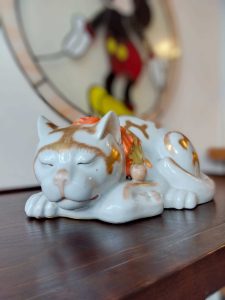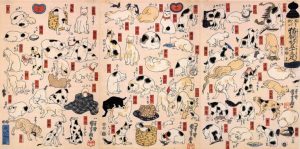ねこの日です(愛知県名古屋市千種区姫池通 骨董買取 古美術風光舎)
2025.02.22
今日は猫の日です。

TVをつければ、たくさんのCMにねこが出演し、ねこ番組が毎週のように放映されています。書店へ行ってみると、毎月のように新刊のねこ写真集やねこ本が発行され、「ねこコーナー」も充実しています。まさに社会を埋め尽くす、ネコの時代といったところ。
少々「ネコ」コンテンツが大渋滞しているような気もいたしますが、統計上でもネコの飼育頭数が伸びていて、ペット界の絶対王者、イヌを逆転したのだとか。「ネコノミクス」なんて言葉も登場するほどで、なんとネコによる経済効果はおよそ2兆円とも言われています。
このような社会現象にまでなっている現在のねこブームは、何もいまに始まったことではないようです。少なくとも江戸時代には、今をはるかに凌ぐような、「ねこブーム」があったようです。江戸っ子たちが猫コンテンツを買い漁り、浮世絵の中でも売れ筋の定番とされたのです。
猫が江戸っ子に文字通り「猫可愛がり」されるようになるまでには、歴史がありました。
日本人と猫といえば、古くは宇多天皇が日記に愛猫のことを記して以来、長く愛されてきたと言われています。『枕草子』にも一条天皇の愛猫について描かれており、昨年の大河ドラマ『光る君へ』でも源倫子の愛猫である小麻呂がすっかり有名になりました。この小麻呂と、彰子の愛猫であった白黒猫の小鞠は、『べらぼう』で「利休」と「半助」として登場しています。
貴族や高貴な人たちの愛玩動物であったねこは、時代が進むにつれてネズミを退治してくれる有益な動物として、次第に庶民にも広まり、江戸時代になると、浮世絵のなかの風景の1つとして、ねこが描かれるようになりました。庶民の生活の中に溶け込んでいたねこが、江戸時代後期に入ると浮世絵の主役として描かれるようになります。
そんな江戸時代後期、まさに「ねこづくし」ともいえるような浮世絵を、いくつも世に出している絵師「歌川国芳」が登場します。
国芳といえば、無類のねこ好き。自画像も猫まみれです。そんな歌川国芳、日本橋から京都まで、東海道の宿駅の名前をもじった、猫の東海道を描いています。その名も「其まま地口 猫飼好五十三疋(みゃうかいこうごじゅうさんびき)」。「地口(じぐち)」とは語呂合わせのことで、国芳が50歳頃に描いた作品です。あまりピンとこない洒落もいくつかあり、親父ギャグ?ちょっと強引?というのもありますが、猫に免じてOKということなのでしょう。

歌川国芳は蔦屋重三郎が没した後に生まれたため、大河ドラマ『べらぼう』には乗れないようで、実はそうでもないようです。蔦屋重三郎と関係がある山東京伝の弟・京山とタッグを組んで『朧月猫草紙』を売り出し、大ヒットしています。また国芳の作品のなかには、当時の人気歌舞伎役者たちの顔を、ねこの顔に模した絵を、うちわにしたものまであったりと、当時の熱狂ぶりを垣間みることもできます。
そのあたり『べらぼう』では描かれるのかどうニャのかは分かりませんが、とりあえず明日の放送も楽しみです!
ではでは、また。(スタッフT)
Today is Cat Day.
If you turn on the TV, you will see cats appearing in many commercials and cat programs are aired every week. If you go to a bookstore, you will find that new cat photo books and cat books are published every month, and the “cat corner” is well-stocked. It is truly an age of cats that fills society.
Although it may seem that there is a bit of a traffic jam of “cat” content, statistics show that the number of cats kept by people is growing, and has even surpassed that of dogs, the absolute king of the pet world. The term “Nekonomics” has even been coined, and the economic impact of cats is said to be as much as 2 trillion yen.
The current cat boom, which has even become a social phenomenon, is not a new phenomenon. At least in the Edo period (1603-1867), there was a “cat boom” that far exceeded the current cat boom. Edo people bought cat contents and they were considered the best-selling standard among ukiyoe prints.
There was a history behind how cats came to be literally “cat-adorable” by Edo people.
It is said that Japanese people have long loved cats since Emperor Uda wrote about them in his diary. The Pillow Book also describes Emperor Ichijo’s beloved cat, and Komaro, Minamoto Rinko’s beloved cat, was made completely famous in last year’s historical drama “Hikaru Kimi e” (To the Loving Prince). This Komaro and Komari, a black-and-white cat that was Akiko’s beloved cat, appear as “Rikyu” and “Hansuke” in “Belabo.
Cats, once the pets of nobles and noblemen, gradually became popular among the common people as beneficial animals that could kill rats as time went by, and in the Edo period, cats came to be depicted as part of the scenery in ukiyoe prints. In the late Edo period, cats, which had been integrated into the daily lives of the common people, began to be depicted as the main characters in Ukiyo-e.
In the late Edo period, a painter named Kuniyoshi Utagawa produced a number of Ukiyoe paintings that could be described as “cat-obsessed.
Kuniyoshi was an unrivaled cat lover. His self-portraits are also covered with cats. Kuniyoshi Utagawa depicted the Tokaido Highway with cats from Nihonbashi to Kyoto, named after the stations of the Tokaido Highway. The name of the painting is “Myaukai ko gojusanbiki” (53 cat-owning tours). Jiguchi” is a pun on the word ‘jiguchi,’ and Kuniyoshi painted this work when he was about 50 years old. There are a few puns that do not really fit. A bit forced? But I guess it is OK because of the cat.
Kuniyoshi Utagawa was born after Shigsaburo Tsutaya died, so he does not seem to be able to get on board with the great drama “Belabo,” and in fact, he is not. He teamed up with Kyozan, the younger brother of Santo Kyoden, who was related to Tsutaya Shigesaburo, to market “Oborozuki Neko Zoshi” (Oborozuki Cat Paper), which was a big hit. Among Kuniyoshi’s works, there are even uchiwa (Japanese fans) with the faces of popular Kabuki actors of the time imitated as cats, which gives a glimpse of the enthusiasm of the time.
I don’t know if this will be depicted in “Belabo” or not, but I am looking forward to tomorrow’s broadcast!
See you all later.
*****************
ご実家の整理やお片付けなどをされている方のご相談などが多くございます。
お片付けなどくれぐれもご無理のないようになさってくださいませ。
風光舎では古美術品や骨董品の他にも絵画や宝石、趣味のお品など様々なジャンルのものを買受しております。
お片付けをされていて、こういうものでもいいのかしらと迷われているものでも、どうぞお気軽にご相談下さいませ。
また風光舎は、出張買取も強化しております。ご近所はもちろん、愛知県内、岐阜県、三重県その他の県へも出張いたします。
まずは、お電話お待ちしております。
愛知県名古屋市千種区姫池通
骨董 買取【古美術 風光舎 名古屋店】
TEL052(734)8444
10:00-18:00 OPEN
#出張買取#骨董#古美術#骨董品#絵画#版画#茶道具#刀剣#彫刻

